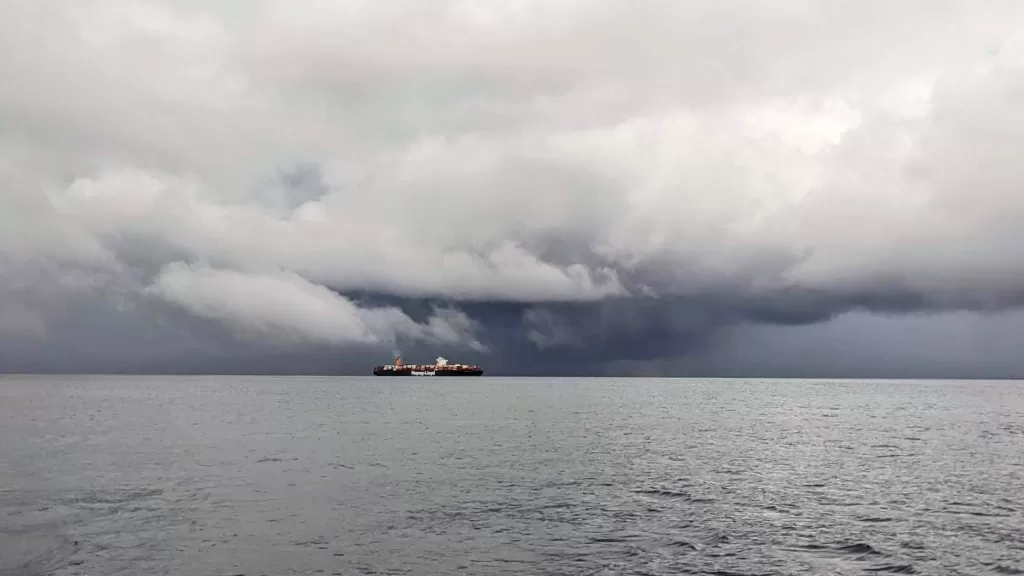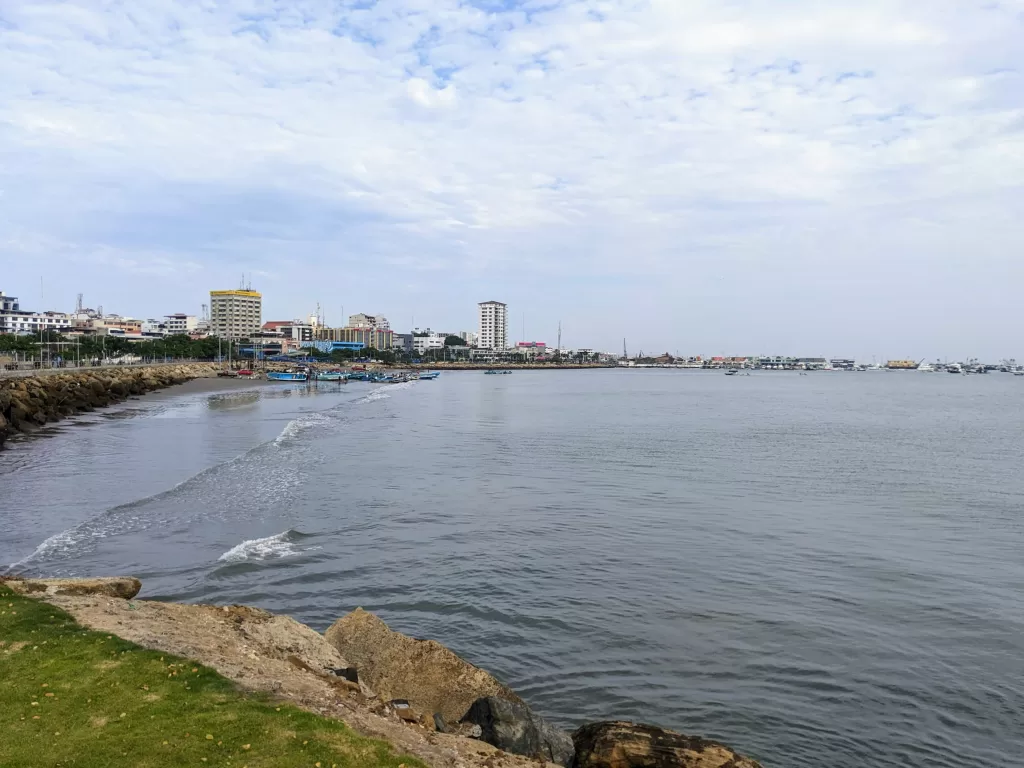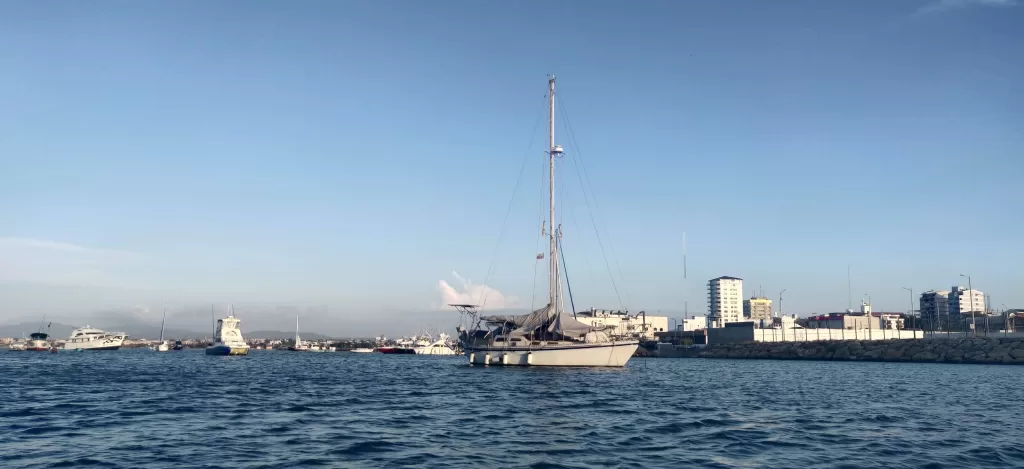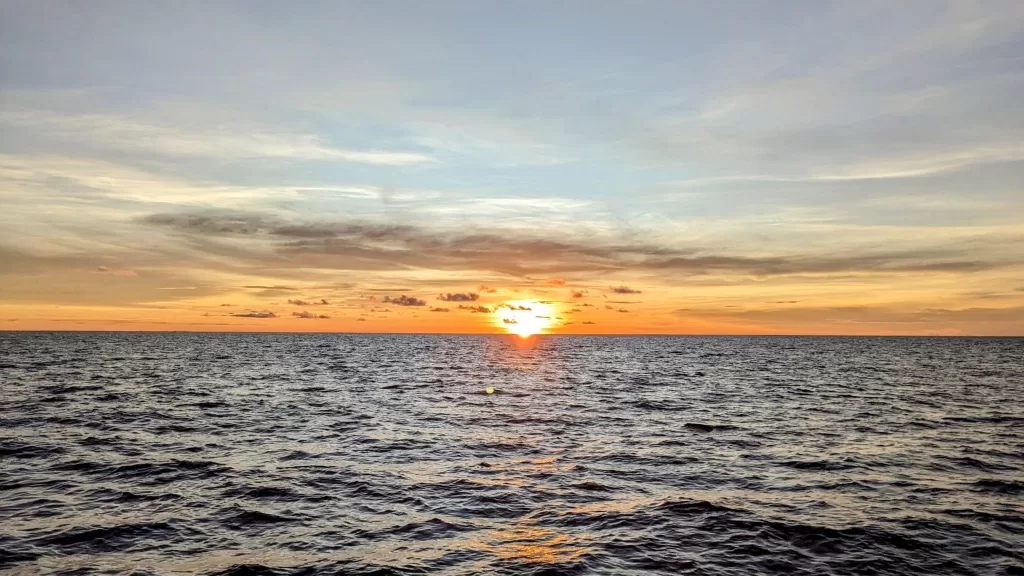You might remember how excited we were to sail to South America. Well, we made it to Ecuador. Not one of our planned destinations and a rather rough experience.
After working on many items on our boat to-do list, provisioning, and otherwise preparing the boat and ourselves for the long journey ahead, we finally proceeded to clear out of Panama at the beginning of May.

After visiting the port captain and requesting the Zarpe, the document that proves that we had paid all fees ($105 as of January 2023), we first had to pay for my overdue visa at the immigration office in Balboa. Each month overstayed incurs a fee of $50 which in my case ended up being $100. Not recommended but worked for us in a pinch since travel to Costa Rica or elsewhere out of the country and then re-enter Panama would’ve certainly cost more. Now was also the time to activate our satellite hotspot, the Iridium Go, so that we could download weather data while underway and contact our families to let them know how things were going.

As we set sail for departure from Panama, we had great following winds (12-15 knots) and made great time. Unfortunately due to the following winds, we let out the mainsail far enough that it chafed on the upper spreaders and now there is a small hole that will require patching.
As we exited the flow of perfect winds, we entered the no-wind zone and had to start motoring. Other option would have been to listen to the sails smacking back and forth as we sit bobbing in the open ocean. Unintentionally, we timed it perfectly and crossed the equator on our 12th wedding anniversary. We saluted Neptune or in our case Rua Hatu, the Polynesian god of the ocean and thanked him for our good fortunes aboard Rua Hatu and the Pacific Ocean thus far.

For good measure
I guess we didn’t thank him enough, because on day 8 I took a look around at all the running (ropes that adjust the sails) and the standing rigging (wire rope cables that hold up the mast) and noticed the forestay starting to fray at the top. This is the equivalent of a flat tire on a car. You can limp along but you will cause great damage to your vehicle. In our case we had to minimize sail area immediately and get to a harbor to be able to replace the forestay’s wire cable.

Diverting to Ecuador
At this point we were about 100 nm off the cost of Ecuador and decided to divert to Manta. Knowing that Ecuador is particular about entering the country we contacted the Ecuadorian Navy to receive permission to enter Ecuador due to this emergency. We promptly received clearance to enter and proceeded to provide them with status updates every 12 hours so in the event the forestay completely detached, the Navy would be able to dispatch assistance immediately and know our location.

Upon arrival in Manta early just after sunrise, a couple of water taxis already came to escort us into the harbor, wanting us to tie to their moorings and pay them to watch Rua Hatu. We didn’t feel comfortable tying up to the very rusty moorings and decided to proceeded to anchor next to Yacht Club. Manta is busy with lots of water taxis darting between fishing trawlers and many derelict vessels. To the side is a long dock for the big fishing fleets to unload and restock. Unfortunately this made the water and air very smelly and polluted.
That same day upon flagging down a water taxi, as there is no dinghy dock where we could’ve tied our dinghy to, we went to port captain’s office to clear into the country. It turns out an agent is required to be able to do so. Locals found us an agent and his daughter who could translate a bit. Upon clearing in with the help of the agent which cost (entry fee plus agent) $500. The entire clearing in process took two days. We had three officials visit us on board (Health, Armada aka Navy, and Immigration). They seemed very amused as it seems not many, if any, cruising sailboats visit Manta (ever?). We were basically treated as if we were a commercial vessel, which explained the need for an agent.

Thankfully, the agent and his daughter offered to drive us around to various chandleries and boat supply stores but none were selling wire rope in the size we needed or in 316 stainless steel. So we went back to the drawing board. Nic went ahead and detached the forestay from the top of the mast to inspect the Sta-Lok terminal and the wire rope to see what had actually happened.
Troubleshooting our forestay

In the pictures above you can see how the wire rope had started to unwind. Looking closely inside the Sta-Lok terminal, it almost looked as if someone cut over half of the 19 wires clean with a knife (impossible!). We looked closely but couldn’t find any visible corrosion which would’ve explained the break. Now we still don’t know why those wires broke off but at this point we are not willing to risk any larger damage to the boat and are planning to replace all the wire rope on the boat. But to be able to do the replacing, we needed to source 316 stainless steel wire rope that fits with Sta-Lok terminals.

After discussing our options, we decided to abandon our plan of sailing to Chile and return to Panama. Even with the fixed forestay we did not feel confident we could make the trip to Chile in light of the fact that diverting in an emergency would be exceedingly complicated. But before we could return to the open ocean, we had to figure out a way to reattach our forestay. Since no stainless steel wire rope in our needed size was to be found in Ecuador, Nic decided to try to re-wind the wire rope and attach a new Sta-Lok terminal. He hoped there was enough extra wire rope in the turn buckle to allow for reattaching the wire to the top of the mast. And it worked! After working until the late hours one night, he was able to reattach the forestay and tighten it back to the boat’s specifications without issues. We couldn’t believe our good luck!

Adjusting our attitudes
After a total of six days spent in Manta, we refueled, expecting to encounter little wind on our way back to Panama, and told the agent to get our Zarpe ($180) ready for departure. Slowly our moods began to improve again. These days in Ecuador were, for so many reasons, very hard on both of us and our morale. Still not understanding why the wire rope failed, we had lost our confidence and motivation for sailing. But we had to keep going and we are happy we did!

Another incident
Upon departure we motored for about 40 hours when our diesel engine suddenly shut off in the middle of the night. Our blood pressure was rising again! One of our two tanks was completely empty. We couldn’t figure out what happened. We had been calculating the engine’s diesel usage to be roughly 0.6 gallons per hour. But in these 40 hours, the engine must have used up upwards of 1 gallon per hour. Again, we still can’t figure out why this happened. Thankfully we had another tank full of diesel. But it should have already siphoned into the now empty tank. After changing the valve positions between the two tanks and being unable to keep the engine running, at 3 in the morning we decided to pour our spare 5 gallons on deck into the empty tank.
After successfully starting the engine again, Nic was mentally preparing to siphon the diesel from the full into the empty tank. Thankfully, after running the engine for an hour and checking the tank levels, we discovered that now the full tank had siphoned into the empty tank. Hooray! But again, we were baffled as to why now the siphoning worked without issues. After this three-hour ordeal, we have decided to closely inspect our fuel system from the tanks to the engine once we arrive in Panama as we were unable to pinpoint the exact cause of this issue. Our to-do list is growing again.


